Jake Adelstein's Blog, page 17
October 9, 2019
Insult Comedy Goes International as Tokyo Roast Battle Takes on Shanghai
 Tokyo Vs Shanghai in a stand-up competition guaranteed to make the authorities rise up in anger and amusement.
Tokyo Vs Shanghai in a stand-up competition guaranteed to make the authorities rise up in anger and amusement.Competitive insult comedy takes a huge step forward as Tokyo Roast Battle squares off against the Shanghai League in Asia’s first ever international Roast Battle competition, the winning city taking home the inaugural Chalice of Malice trophy.
Shanghai will be represented by three comedians flying in for the show. The card is headlined by Fukuoka TV personality and Japanese Champion Bobby Judo (USA), who faces stand-up comic and Shanghai tournament winner Eric Alexander (Canada) to determine who will become the first East Asia Champion.
Note: To really get into the spirit of Chinese comedy, facial recognition technology will be employed at the venue to see who laughs at the Red China jokes, so they can be rehabilitated at at a later date. Visitors from Hong Kong can get masks at the front desks but are not allowed to vote. Any jokes pertaining to Japan’s Conspiracy Laws should be reported to the Abe Cabinet Intelligence office after the show.
Roast battle is a 7 year old comedy format that originated at the World Famous Comedy Store and is now being performed all over the world. Comedians go head to head in hilarious insult battles reminiscent of rap battles, only much funnier & meaner. Roast Battle has had 3 successful seasons on Comedy Central and has spawned spinoffs in the UK & Canada.
Tokyo Roast Battle (TRB) was founded by Canadian comedian JJ Wakrat in 2017. Although there had been a handful of one night tournaments and events in Asia. TRB was the first league of its kind. It has been very well received in straight-laced Japan, selling out every single show to date.
According to JJ, what makes this show so special is how it embraces diversity without pulling any punches. “This show is super intense. It’s just about the least polite thing you can witness in Japan. But what makes it work is the love and affection the comedians have for their opponents”.
Regular shows and tournaments have since been promoted in cities like Shanghai, Bangkok, Saigon, & Singapore. With the growing popularity of Roast Battle, it was inevitable that some form of International competition would develop. Tokyo Roast Battle: Shanghai vs Tokyo is the first Intercity friendly match, but certainly not the last. An All-Asia Invitational tournament is planned for the spring with Roast Battle on Comedy Central Season 2 Champion Frank Castillo set to judge.
Tokyo Roast Battle: Shanghai vs Tokyo takes place October 18th at Good Heavens in Shimokitazawa. Reserving tickets ahead of time is strongly recommended: www.tokyoroastbattle8.peatix.com
Full Fight Card
Main Event: (3 rounds)
TV Host Bobby Judovs Eric Alexanderfor the East Asian Roast Battle Championship.
Co Main Event: #1 Contender bout (3 rounds)
2 Time Tokyo ChampionBill Millervs Shanghai Roast Battle finalist Gene George.
Tokyo comedy legend Vinay Murthymarks his Roast Battle return against Shanghai show-runner Dan R. in a tit-for tat shootout.
Tokyo Closet Ball founder Tatiana faces off against Vietnam’s Stefani St. Sl*t in Asia’s first ever Drag Queen battle.
Venue
Good Heavens British Bar Tokyo (SHIMOKITAZAWA)
Address:5丁目-32-5 Daizawa, Setagaya, Tokyo 155-0032
Time & Date
Friday, Oct 18 @ 8:30.
Promoter
Stand Up Tokyo
Contact
jjwakrat@gmail.com
Tickets:
September 12, 2019
No More Dashi: Four Delicious Vegan Restaurants In & Around Tokyo
by Anna Wildman
Eating vegan (a diet containing no animal products whatsoever) in Japan can be frustrating, given that most Japanese don’t seem to have even have the word “vegetarian,” let alone “vegan,” in their vocabulary. Even in Tokyo, one of the world’s most cosmopolitan cities, dashi (bonito fish flake stock/seasoning) seems to be in almost everything– from miso soup to potato chips. The “Impossible Burger” hasn’t quite made it to Japan.
Oftentimes, even the menus at veggie-forward restaurants (often with names that include the words “farmer” or “yasai,” meaning vegetable) are mostly meat-centric dishes with some organic veggies on the side.
While culturally, eating vegan hasn’t hit the mainstream in Japan quite yet due to various reasons, the vegan restaurants that do exist here are high quality and often very cozy and inviting.
Below are four 100% vegan restaurants in or near Tokyo that I encourage you to try, or would encourage anyone to try. They are all quite different in terms of location and type of food, but the one thing that they all have in common is value — and the safety of knowing you are eating in a place that knows what it means to be vegan.
Saido
Located in Jiyugaoka, one of my favorite neighborhoods, is known for its trendy vibes and romantic streets, Saido (meaning vegetable street) is truly a hidden gem. After walking through a lush garden, expect to be greeted by a very cheerful and friendly Japanese woman. She will explain the menu to you in detail, giving suggestions (osusume) along the way. At lunch time, for about 2,000 yen you will receive a three-course meal that comes with soup, a gastronomic wonder of a salad that emits smoke when opened, and then the main course. Choose from one of the many noodle dishes (e.g. yakisoba, abura soba, ramen, tsukemen), unagi-don, katsu-don, or curry.
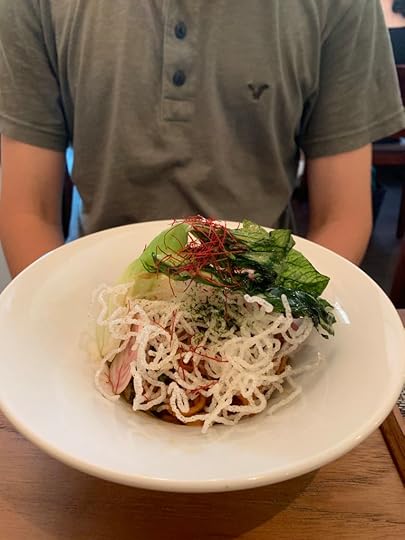
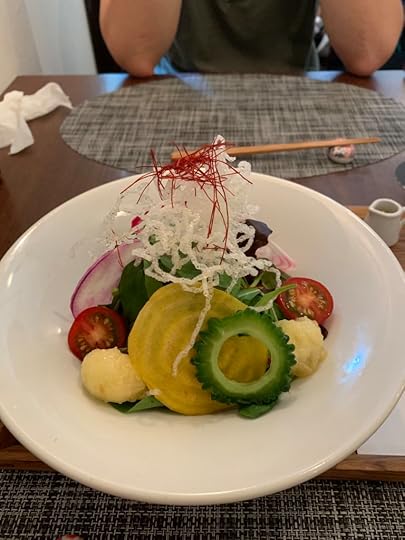
2 Chome-15-10 Jiyugaoka, Meguro City, Tokyo 152-0035
Closest Station: Jiyugaoka
Olu Olu Cafe
A somewhat cluttered, homey Hawaii-inspired 100% vegan restaurant in the Sangenjaya neighborhood near Shibuya. Their menu is quite varied, with choices from hot fried (soy-based) chicken to ramen.
The jambalaya there is one to write home about– or write an article about. Flavorful, subtly spicy, quality mock meat, and not too oily. All main course meals are from 900-1,200 yen, and portions are fairly large.

Once you’re done eating, head outside and walk around the area. There are plenty of parks, coffee shops, and clothing stores to be explored.
https://oluolucafe.amebaownd.com/
1 Chome-11-1 Ikejiri, Setagaya City, Tokyo 154-0001
Closest Station: Sangenjaya
Kousaiken Gu
Since this restaurant is actually in Kamakura, it’s technically outside of Tokyo. Get on a train and go to the beach when you’re done. Even if you don’t go to the beach, it’s worth the trip thanks to its charm and quality.
It is almost hidden, located just up the street from the crowded beaches of Kamakura in a very quiet and residential neighborhood.
The restaurant has a mix of Japanese and Indian food with very limited seating– one inside and two outside seating area (with covering). The family who owns it originally operated the restaurant out of Nerima-ku in Tokyo, but moved it to Kamakura in 2017 where they have been running it ever since. They are very friendly and love to chat in English, so it’s a great place for tourists looking to take a break from kanji-riddled menus and staff with limited English abilities.
For 2,000 JPY, one can get soup, a large vegetable plate, curry, rice + puri, dessert, and tea. I was blown away by the value. My favorite was the vegetable plate, which came with about 10 different types of vegetables, all cooked in different ways.
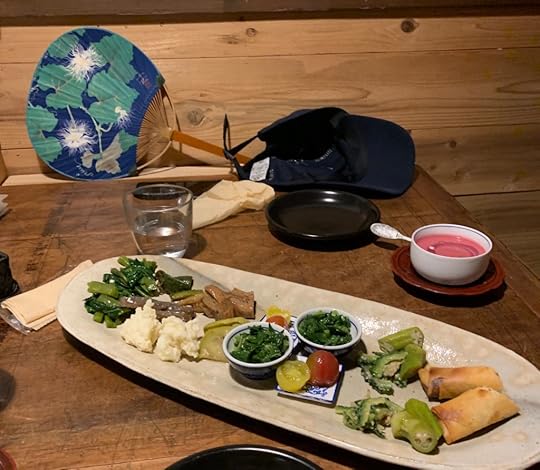
https://tabelog.com/kanagawa/A1404/A140402/14063693/
3 Chome-1-7 Zaimokuza, Kamakura, Kanagawa 248-0013
Closest Station: Wadazuka
Nagi Shokudo
Conveniently located in Shibuya, it’s a tiny place with only two staff members including the chef.
This is meant to be a traditional Japanese restaurant vegan-ized. They serve up karaage, seasonal veggie dishes, curry, miso soup, and more. If going for dinner, I recommend the couple deli plate for two. It includes a sampling of all of their different dishes for just 4,200 yen.
View this post on InstagramA post shared by Vegan | Food | Travel (@veganfoodquest) on Oct 12, 2018 at 3:50pm PDT
https://tabelog.com/en/tokyo/A1303/A130301/13048497/
15-10 Uguisudanicho, Shibuya City, Tokyo 150-0032
Closest Station: Shibuya
Some online resources to find vegan food:
https://www.happycow.net/asia/japan/
Welcome
September 11, 2019
Songs Of Winter Denial
Julie Yukiko (雪子) Buisson aka Ukico has much in common with Snow-White, other than just her name, which literally means “child of the snow”—she is charming, peaceful, a beautiful woman with alabaster skin and blessed with an ethereal singing voice that calms the spirits of men and animals; she is enchanting. Her first song, Denial, and the surreal mystical music video for it were released on September 11.
She was born to a Japanese mother and French father and grew up in Paris. You could say she has made the best of her bicultural heritage, touching upon her roots to become a successful model and now a songwriter and singer. Her French-Japanese visage and sense of style helped her have a successful international modeling career.However, she has much more depth than her surface appearances, and that is part of her appeal.
Ukico (pronounced You-Key-Koh) was studying at the University La Sorbonne while pursuing her modeling career after high school. What sparked her interest in singing and songwriting was the death of her grandmother.
 Ukico
Ukico photo by Yulia Shur
make-up by Laurene Baudin
When she passed away, Ukico, wrote a poem as a eulogy, which she showed to her father—and to her surprise, he wept.
“It moved my father to cry and it showed me how to paint a picture with words. He still reads the poem, sometimes.” She felt the power of words come to life.
She had often thought about becoming a singer/songwriter but lacked confidence in her ability to compose or to voice her emotions musically. But seeing her father’s response stirred something inside of her.
“It was a wake-up call. I had always dreamed of studying and living in New York and pursuing music. I love so many different genres and singers. Everything from Massive Attack, to Little Dragon, to Lana Del Rey.”
The song writing of Fiona Apple was particularly inspirational to her.
To pursue her musical career more seriously she entered a music engineering school in NYC, The Institute of Audio Research. After graduating salutatorian, she interned at the recording studio Strange Weather based in Brooklyn.
She was given an opportunity to work on the production of 36 Seasons by Ghosface Killah. She also put in time at the world famous jazz club Birdland, live mixing for the Grammy Award winning band The Afro Latin Jazz orchestra, and other jazz acts.
While in New York, she experienced the loneliness, alienation and emotional struggles that come with life in the Big Apple.
She sought refuge in spiritual disciplines, yoga and meditation, eventually becoming adept enough to guide others.. Meditation and yoga are still a huge part of her life, and perhaps what gives her an aura of warm serenity—not the chilly vibe you’d expect from a snow woman.
During her time in New York, she was also taken under the wing of Justyn Pilbrow, a respected music producer who has handled major acts such as Halsey and The Neighbourhood.
After leaving New York and coming back to Japan she also became more interested in her own Japanese background and traditional music. It provided her with some solace as
She continued to work with Justyn Pilbrow and was also able to collaborate on musical pieces with Japanese virtuosos of Koto (Japanese lute), Shamisen, Shakuhachi (windpipes) and the Taiko (Japanese drum).
Her first single, Denial, has instrumentation featuring the shakuhachi and taiko. “The shakuhachi is such a beautiful instrument—it can express so much pain and tension.”
The video of the song is based on the story of Japan’s creation, as told in the Kojiki, a classic of ancient Japanese literature. The creation of the world starts with the first two existing Gods Izanagi (male God) and Izanami (female God). After forming Japan’s islands they gave birth to other gods—the god of the wind, seas, and more. But Izanami, after giving birth to the God of Fire dies from the trauma and fatal wounds. Her spirit goes down to the underworld. Izanagi who misses her terribly, decides to descend to the underworld to bring her back—like Japan’s own Orpheus.
The video, using Butoh dancers, brings to life the myth of creation, death and renewal. But what is the song about on a personal level? Fasting? Living without material goods? Denial of French culture, or Japanese culture?
Ukico answers, “It is a song about breaking up and the end of love. But it is a bit more than that. I was protecting my heart, not to fall in love again. I was in denial of closing my heart when I started to write it. But also there was underlying denial that I am mad at somebody.
But the real denial in the song is that I am angry at myself. It is because of myself, because of how I am choosing how to deal with things that the suffering comes. And there is some wisdom and transmutative power in understanding that.”
Songs Of Winter Desire
Julie Yukiko (雪子) Buisson aka Ukico has much in common with Snow-White, other than just her name, which literally means “child of the snow”—she is charming, peaceful, a beautiful woman with alabaster skin and blessed with an ethereal singing voice that calms the spirits of men and animals; she is enchanting. Her first song, Desire, and the surreal mystical music video for it were released on September 11.
She was born to a Japanese mother and French father and grew up in Paris. You could say she has made the best of her bicultural heritage, touching upon her roots to become a successful model and now a songwriter and singer. Her French-Japanese visage and sense of style helped her have a successful international modeling career.However, she has much more depth than her surface appearances, and that is part of her appeal.
Ukico (pronounced You-Key-Koh) was studying at the University La Sorbonne while pursuing her modeling career after high school. What sparked her interest in singing and songwriting was the death of her grandmother.
 Ukico
Ukico photo by Yulia Shur
make-up by Laurene Baudin
When she passed away, Ukico, wrote a poem as a eulogy, which she showed to her father—and to her surprise, he wept.
“It moved my father to cry and it showed me how to paint a picture with words. He still reads the poem, sometimes.” She felt the power of words come to life.
She had often thought about becoming a singer/songwriter but lacked confidence in her ability to compose or to voice her emotions musically. But seeing her father’s response stirred something inside of her.
“It was a wake-up call. I had always dreamed of studying and living in New York and pursuing music. I love so many different genres and singers. Everything from Massive Attack, to Little Dragon, to Lana Del Rey.”
The song writing of Fiona Apple was particularly inspirational to her.
To pursue her musical career more seriously she entered a music engineering school in NYC, The Institute of Audio Research. After graduating salutatorian, she interned at the recording studio Strange Weather based in Brooklyn.
She was given an opportunity to work on the production of 36 Seasons by Ghosface Killah. She also put in time at the world famous jazz club Birdland, live mixing for the Grammy Award winning band The Afro Latin Jazz orchestra, and other jazz acts.
While in New York, she also became more interested in her own Japanese background and traditional music. It provided her with some solace as she experienced the loneliness, alienation and emotional struggles that come with life in the Big Apple.
She sought refuge in spiritual disciplines, yoga and meditation, eventually becoming a teacher herself. Meditation and yoga are still a huge part of her life, and perhaps what gives her an aura of warm serenity—not the chilly vibe you’d expect from a snow woman.
During her time in New York, she was also taken under the wing of Justyn Pilbrow, a respected music producer who has handled major acts such as Halsey and The Neighbourhood. Working with him, she was able to collaborate on musical pieces with Japanese virtuosos of Koto (Japanese lute), Shamisen, Shakuhachi (windpipes) and the Taiko (Japanese drum).
Her first single, Denial, has instrumentation featuring the shakuhachi and taiko. “The shakuhachi is such a beautiful instrument—it can express so much pain and tension.”
The video of the song is based on the story of Japan’s creation, as told in the Kojiki, a classic of ancient Japanese literature. The creation of the world starts with the first two existing Gods Izanagi (male God) and Izanami (female God). After forming Japan’s islands they gave birth to other gods—the god of the wind, seas, and more. But Izanami, after giving birth to the God of Fire dies from the trauma and fatal wounds. Her spirit goes down to the underworld. Izanagi who misses her terribly, decides to descend to the underworld to bring her back—like Japan’s own Orpheus.
The video, using Butoh dancers, brings to life the myth of creation, death and renewal. But what is the song about on a personal level? Fasting? Living without material goods? Denial of French culture, or Japanese culture?
Ukiko answers, “It is a song about breaking up and the end of love. But it is a bit more than that. I was protecting my heart, not to fall in love again. I was in denial of closing my heart when I started to write it. But also there was underlying denial that I am mad at somebody.
But the real denial in the song is that I am angry at myself. It is because of myself, because of how I am choosing how to deal with things that the suffering comes. And there is some wisdom and transmutative power in understanding that.”
September 3, 2019
Weathering With You (Review)
by Kaori Shoji
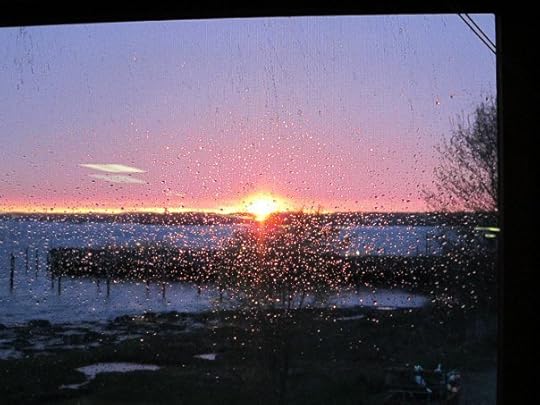 Imagine a rainy day that lasted forever
Imagine a rainy day that lasted forever Certain facts of life we know to be true. The tide will turn. The sun will rise. Hayao Miyazaki is the god of Japanese anime. Still, the throne may be ready for a shakedown – or even a partial step down on the part of Miyazaki. Anime filmmaker extraordinaire Makoto Shinkai (Your Name) has blown a huge hole in the fortress of Miyazaki’s storied production company Studio Ghibli, with his latest: Tenki no Ko (International Title: ‘Weathering With You’).” It’s a semi-utopian spin on the dismally dystopian subject of climate change, and the ending has instigated a controversial firestorm on social media. The question at the eye of the storm is this: “Should we forgive the protagonists for putting their personal happiness before the greater good?”
Though the verdict is still out, my guess is that Hayao Miyazaki would probably say a loud “no way”. As the ultra-stoic-but-always-benevolent tyrant of Japanese anime, he has consistently sacrificed his characters’ romantic inclinations to “much bigger things,” as he once said in an interview – i.e., the benefit or survival, of human society. In a Miyazaki story, boy and girl will get to meet but they will never get together, as there are much bigger things at stake.
In Weathering With You the Tokyo metropolitan area is locked into a rainy season that won’t go away. No one has felt the feeblest of sunshine or glimpsed a patch of blue sky for months. The only exit out of this perpetual wetness seems to lie in the hands of a pretty teenage girl named Hina (voiced by Nana Mori) Her sort-of-boyfriend Hodaka (voiced by Kotaro Daigo) is sort of her boyfriend, because they don’t exchange so much as a kiss–gleans Hina’s secret power. Initially, he advises Hina to cash in by starting a fair weather business and Hina agrees to go on social media and advertise her abilities as the “good weather girl”. Soon, orders for good weather start pouring in and Hina is summoned to a barbecue party here, a sports event there, or even an ancestral ritual at an old lady’s home. The money’s not bad either, and as Hina’s little brother Nagi (voiced by Sakura Kiryu) joins in, the trio start to feel like a cozy little family.
Sixteen-year old Hodaka is too shy to admit his love for Hina–especially since she has informed him that her 18th birthday is coming up and therefore, she’s way too old for a kid like him. That doesn’t stop Hodaka from going online and researching the perfect birthday gift, which he buys with the money he made with Hina. All this will most certainly elicit stern disapproval from their parents but thankfully, there are no such people in Weathering With You. Hodaka has run away, from home and parents left behind on one of the Izu islands scattered along the Pacific. Hina’s mother died a short while ago and she is supporting Nagi in a tiny apartment near Shinjuku. First, she was on the night shift at a McDonald’s and when that didn’t work out, she made a half-hearted attempt to become a porn actress before Hodaka pulled her back.
All the while, the rain never stops.
Fans of Shinkai know dark skies and heavy rains are a big part of his m.o. Plus, the precise, almost photographic depictions of Tokyo’s train stations (mostly the Yamanote line) and streets, especially in the Shinjuku area. Weathering With You has ample portions of both – the story opens on rain-soaked streets, inky puddles and the lesser known alleyways in the Yoyogi neighborhood. When Hina clenches her fingers and prays to the heavens, the clouds part, exposing a glorious patch of azure sky and splendid slants of sunshine. People put their umbrellas away to look up with a smile, and Hodaka rightly observes that “it’s amazing how good you feel when it’s cleared up.”
The contrast of bad weather and good, is one of the factors that propel the story forward – you get a feeling of how badly people need the sun, and what lengths they will go to get it.
The implication is that Tokyoites are ready to sacrifice Hina on the altar of blue skies, even if they’re only very vaguely aware of her powers or even her presence. In the movie, Hina is a ghostly figure whispered about on the Net, and her abilities are never totally understood. The terrible truth is that the more Hina makes good weather happen, the less there is of her own self; her trade-off with fine weather is her own, physical existence.
One morning when Hodaka wakes up, she’s gone without a trace, save for the bathrobe she was wearing the night before.
(SPOILER ALERT: That is nowhere near the ending for Hina or Hodaka、so don’t let this review make you feel like we’ve ruined the movie.  )
)
In reality, Japan braces itself for a rainy season (usually occuring at the beginning of June and lasting four to five weeks) that wreaks havoc on many areas across the archipelago. This year, southwestern Japan was flooded by torrential rains and in Fukuoka city, trucks and cars were submerged in rainwater while soil erosion led to landslides that caused thousands of people to lose their homes. Tokyo wasn’t as bad but enough water came down to partially shut down public transportation and delay construction on Olympic facilities.
In Weathering With You rainfall spells dire consequences for the metropolis as entire neighborhoods disappear underwater and mighty architectural monuments like the Rainbow Bridge, become steeped in water. Still, as a sage old woman in the movie remarks, “It’s all right, Tokyo has gone back to its natural state. That’s all this is.” Indeed, the Japanese capital is a 400-year old artificial island made on a landfill and the greater part of Shinjuku as we know it today, used to be swampland. If we can live with that, surely we can live with Hina getting to have a life of her own, and maybe, eventually–perhaps–falling in love with Hodaka. And the greater good be damned.
August 24, 2019
A Requiem For Kyoto Animation (KyoAni)
The popular multi-lingual singer, Elizaveta, has released a tribute song “Meet Again” to those who lost their lives in the terrible arson attack on beloved anime studio, Kyoto Animation (KyoAni).
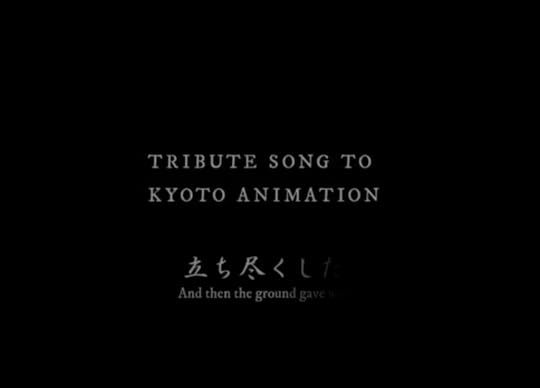 https://www.youtube.com/watch?v=9Xvd0FGCi7M
https://www.youtube.com/watch?v=9Xvd0FGCi7MShe will donate all the net proceeds from sales of this song to KyoAni’s official support fund.
BandCamp: https://elizaveta.bandcamp.com/track/…
iTunes: https://music.apple.com/us/album/meet…
Alternatively, you can donate to KyoAni directly to help them rebuild (official account info after the link): https://www.kyotoanimation.co.jp/info…
Japan Subculture Research Center asked Elizaveta to explain why she wrote the song and for the lyrics to the song. Here is what she had to say.
I wrote “Meet Again” not long after finding out about the tragic fire at Kyoto Animation. I had met some people from KyoAni, although just very casually, through a network of animators and visual artists I am occasionally part of, when in Tokyo.…
I was hoping to be able to tour the studio and visit their shop, when visiting Kyoto next. I was also aware of their positive reputation, as they were known for being an employee-friendly company in an industry, which often overworks and underpays animators. They had a lot of women working for them, too, which was unusual, and a breath of fresh air.
In the hours and days following the tragedy, I couldn’t stop thinking about what had happened, and following the news, which just got more and more grim.
The contrast between the beautiful, hopeful art produced by KyoAni and what happened to them, was very hard to reconcile with. I am not a starry-eyed optimist,
but I do prefer to believe that good things happen to those who put out good things into the world. While I know it’s a naive worldview, it’s better than the alternative. This event, though, was not an accident, but an act of deliberate evil. All circumstances aligned for it to be as awful as could be. It was incredibly hard for me to accept it as reality. There had been no magic hero to save the day, and nothing to soften the blow. Kyoto is a peaceful, mystical city of a few thousand temples. But no deity stepped in to offer protection.
Once you accept that something terrible like this happened and there’s no way to explain it, you must allow for healing to start, or at least attempt to get on the path towards it. I can’t even start to imagine the pain and trauma of those who had gone through this experience and survived are now having to deal, and probably for years to come. My heart also goes out to those who got the call that day to find out their loved ones were no longer with them. Furthermore, the trauma to KyoAni fans around the world may not have been as direct, but it’s real nonetheless. When you make art, those who love and consume it, become believers of the things your art brings into the world. For KyoAni fans, it would have been beauty, hope and harmony. A tragedy such as this one kills faith that the world is in any way fair and a worthwhile place to be part of.
I wrote “Meet Again” the day I went to the recording studio, and the song practically wrote itself. I heard it in my head, and the lyrics came to be just minutes before I walked out to catch the train. This recording is the first take, which we recorded and filmed. It wasn’t quite perfect in a couple of places, and so I did another take, but I had a hard time singing then, because I was too close to tears. And so I made the decision to keep the first take, as it was, and record no more.
I wrote this song as a way to heal myself, even though I was just a bystander of this tragedy. I hope it may serve as a source of healing to others affected by it. I still have hope and faith. There are so many things we do not know, and so much happens every day, which makes it hard to take heart and carry on. But carry on we must, and help those around us do so, too.
I don’t remember when
I got the call that day
They said you were no more
And then the ground gave way
I sat and cried all night
Still hoping they’d been wrong
A part of me had died
How could I carry on
As sunrise painted red
Inside my sleepless eyes
Still lying on my bed
I thought I heard a voice
It sounded like my love
A distant precious sound
But there was not a soul
That I could see around
I know you’re still with me
In other shape or form
Our union has survived
A deadly firestorm
And when I look above
I can transcend the pain
Soar high with me, my love
I know we’ll meet again.
<日本語歌詞>
何時のことか 覚えてない
もういないと 立ち尽くした
泣き明かした まちがいだと
身を裂かれて 歩みようも
夜明けの赤 腫れ目を染め
伏せたままで 聞こえたのは
君のような 遠くの音
影ひとつも 見えないのに
今も そばに 形を変え
つながりだけ 焼け残った
仰ぎ見ては 痛みを超え
君を連れて また会うまで
あの高みへ また会うまで
Born in USA, Russian-raised Elizaveta made her debut on Universal Records (US) in 2012. Since then she became the voice of the Tavern Bard in Dragon Age, has toured USA, Russia and Europe, was a repeat guest performer at the main TED stage, and released a number of multi-lingual recordings, heard in multiple films and TV series. She produced and released an all-Japanese language duet album Mezameru Riyuu earlier this year, followed by a 16-city tour of Japan.
August 12, 2019
British widow fights to know the truth on 34th Anniversary of the Japan Airlines Flight 123 crash.
I am the British widow of Akihisa Yukawa who was one of the 520 victims who died in the Japan Airlines Boeing 747 flight 123 from Tokyo to Osaka crashed into Mount Osutaka – the world’s largest single aviation disaster.
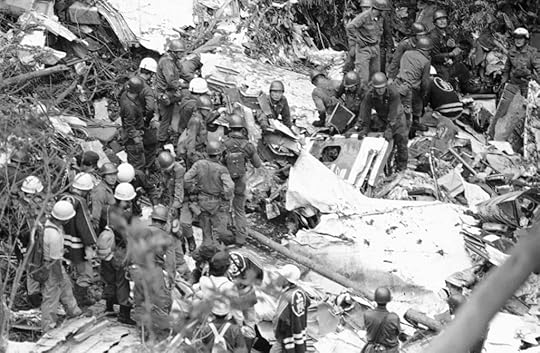
I came to Japan to fight for justice – 34 years after his death. For the first time I have joined the Japanese bereaved to request a reinvestigation of the crash based on new evidence.
On 16th July I participated in a symposium at Waseda University which outlined the need for information disclosure of the Japan Airline flight 123 crash. The details of the symposium are here and why we feel that the real cause of this terrible disaster is still not known–please read here or read the Professor’s comments at the bottom of this post.
I am aware the Japanese government announced in 2000 that the documents about the crash were copied onto microfilms and would never be destroyed. I am joining the bereaved in asking for these documents to be released now. We all know that part of the plane is still in Sugami Bay, I am campaigning to have it salvaged and re-investigated. There is considerable evidence that was not included in the original crash report – these significant new facts simply cannot be ignored. In accordance with international guidelines there is a necessity to re-open the crash investigation based on these facts. This is the worst single Boeing crash in history, the bereaved – and the world deserve to know what really happened. It is a human right to know the truth. Powerful corporations over the world over continue to escape accountability and victims have no route to remedy. I am calling for a new international law to protect everyone from the harm caused by the lack of truth and accountability. I am speaking with a number of Japanese journalists/documentary makers and have agreed to be interviewed on the 12th August on the anniversary of the crash in Gunma.
I am campaigning for the bereaved and my own personal case – both issues are about corporate accountability and transparency.
Akihisa Yukawa and I lived together for seven years as de-facto man and wife and bore him two daughters, we could not have been happier, we had every intention to marry. Akihisa was working as a senior Sumitomo executive at the time of his death, he was building the aviation leasing business for his company. He was working very closely with Japan Airlines before the crash as the lead of the syndicate which led to the largest order of Boeing aircraft on record from Japan in 1985.
This order was announced just nine days before the crash, the aircraft were delivered after his death:
https://www.flightglobal.com/pdfarchive/view/1985/1985%20-%202341.html?search=JAL
On Monday 12th August 1985, Akihisa was requested by his company to attend a business meeting in Osaka.
He was feeling unwell that day and had a very strong sense that he should not go – he tried his very best to cancel but his head office insisted it was necessary for him to go which led to his death in the JAL 123 crash.
I think it is time we all knew the truth about everything that happened.
“””””””””””””””””””””””””””””””””””””””””””””””””””””””
Tohko Aoyama, JAL 123 researcher–
“On July 16, the Waseda University Faculty of Law and the Waseda University Comparative Law Research Institute co-hosted an academic symposium asking for information disclosure of the Nikko flight 123 (JAL123). For the first time, UK bereaved Susan Bailey Yukawa (Susanne Bayly-Yukawa) came to Japan and issued a statement asking for a reinvestigation with Japanese bereaved. Professor Christopher P. Hood at Cardiff University in the UK also sent a video message. The keynote speech was held by Mr. Hiroshi Miyake, a member of the Cabinet Office Public Document Management Act, the Ministry of Internal Affairs and Communications information disclosure system member, vice chairman of the bar association and chairman of the board. I also mentioned the necessity of the reinvestigation. The legal path to reinvestigation has finally come to light.
Now I would like to share with you overseas people about the Nikko123 Flight crash and the story that is not written in the official accident investigation report.
On August 12, 1985, Japan Airlines flight123 crashed in Ueno village, Gunma Prefecture, and 520 people were killed. This is the world’s largest single airplane crash still now. Twenty-two of the victims were foreign nationals, including the United Kingdom, India, the United States, Korea, China, and Italy. At the time I worked for JAL as a stewardess belonged to the same group of the flight attendants who encountered the accident, but I was relieved because of the duties for an international flight. 34 years have passed since then. I got married and retired, put myself in the education world, then got a doctoral degree from the University of Tokyo. In the meanwhile, I have always questioned the cause of the crash of the Nikko123 and continued my research. As a result, I wrote four books.
One of them “New facts of the Nikko123 crash -close to the truth at the eyewitness accounts” breaks through 100,000 copies, thereby making the general public aware of the cause of the accident different from the accident investigation report. After a 34 years survey, I was convinced that the crash of the Nikko123 was not an accident but an incident.
According to the accident investigation report of the official announcement at that time, the aft pressure bulkhead that had been damaged by a hard tail-hit against runway in the landing at Osaka airport in 1978, was repaired in the incomplete manner by Boeing. Its bulkhead broke again in the operation of the Nikko 123 due to a repair error and its mount of pressurized air in the cabin darted out and accumulated inside of the vertical fin, finally blew up the top corner of the fin with pressure. However, despite all this the Japanese judiciary did not prosecute anyone for this reason. In other words, no one had any responsibility for the death of 520 people. It was written that the reason for the crash is that Boeing made a repair mistake and Japan Airlines missed it. But even after the accident, Japan Airlines purchased Boeing’s airplanes in following year one after another. Not only JAL but all rivals of JAL and Japanese Self-Defense Force also purchased aircrafts under the intention of the government (Prime Minister Yasuhiro Nakasone). As a result, Boeing’s sales in Japan were the highest which resulted in 520 victims.
In 2015, News reported that most of the vertical fin and tails constructions blew off were still in the sea. Despite the direct cause of oneself, it is still sunk to the seabed 160m of Sagami Bay, below the flight route. This is the origin of the accident, nevertheless the Japan Transport Safety Commission which is in the Ministry of (Land, Infrastructure,) Transport (and Tourism,) refused the wishes of the bereaved and rejected to pull them up from the seabed for the reinvestigation. It was natural to do so because of a lot of doubts and an unconvincing non-prosecution.
I will briefly explain why they refuse so much, based on the facts.
The accident investigation report disregarded all the testimonies of many witnesses.
According to them, immediately after the emergency happened on JAL 123, the two phantoms that were launched urgently tracked the JAL aircraft, and near the crash point, local children said “A large airplane and two small airplanes are chasing” they were sure to look the situation.
In the ultra-low altitude flight of JAL 123, it was observed that an elliptical thing like a red airplane was stuck near the fuselage. In the vicinity of the crash site, adults also witnessed a bright red small plane flying. A non-duty SDF member witnessed that two SDF Phantom aircrafts were flying in an unusual situation, and this was described in the police report too.
I interviewed the chief of Ueno village of a crash site (Takeo Kurosawa). He said that he called the central government many times for crashing in his village. Nevertheless, coverage of the unknown continued throughout the night.
In the village at the crash site, many people gathered, including many SDF vehicles, police and riot police and so on, all night long. There was a big fire at the crash site on the mountain and there were many helicopters on it. It had been witnessed that they were going back and forth and raising and lowering things.
According to Mr. Antonucci’s testimony of the US military, the crash site was identified in 15 minutes after the accident, “so I went for relief, but the Japanese rescue team came and ordered a return”. However, he knew a report next morning that it was unknown all night, and he was hampered to say nothing.
If the two Phantoms were flying with JAL 123 at a bright time before the crash, the location was identified and reports that “the crash site was unknown all night” would not be held. In response to this comment, the SDF’s official announcement said that one minute after the crash, we sent out two phantoms, but we did do nothing before that, we had not had even one fly.
So what did the Japanese government and the Self-Defense Forces do all night without saving the passengers? I also briefly report scientific findings.
(1) I examined the remains (a few rocky blocks) collected at the crash point with a university research institute. As a result, it was found that the material was made of duralumin and was the remnant of JAL 123. Further, when black deposits were analyzed, a large amount of benzene ring, sulfur, chloroform were detected. Jet fuel used by JAL was kerosene JTA-1, which was a good product of high purity refined from kerosene, so why is a large amount of gasoline component benzene ring and sulfur detected in the crash site? This is a biggest question. Naturally, there was no gasoline on the product also no sulfur component in this mountain. Furthermore, why was the non-load chloroform attached?
(2) According to the detailed data for the condition of the body that was obtained and analyzed by the autopsy doctor, one third of the bodies were abnormal carbonized, one third of them were complete bodies, and another two thousand fragmental parts of bodies. The plane crashed on the summit of the ridge called “Osutaka no One” was broken into four parts, and one of them, the E compartment just in front of the rear pressure partition where the four survivors were sitting, slipped off from the summit and fell to a point completely invisible from the summit. It was deep bushes of trees.
Their tympanic membranes were normal despite the survivor experiencing a sudden decompression as the vertical tail blew off. The four survivors were listening to a large number of voices and encouraging each other. However, the helicopters flying above did not rescue them. According to the doctor, “100 people must be alive if they were discovered immediately after the crash”. In the crash site near the summit, the flames were rising until morning, and according to a local fire brigade who accidentally found a survivors, it was full of gasoline and tar odors. Why was the smell of non-load dangerous goods gasoline full? Tar was not a cargo. What did the existence of the SDF helicopters witness around the scene all night tell you? By the way, the components of the weapon fuel (flamethrower) possessed by the SDF members were gasoline and tar.
⑶ According to the autopsy doctor, there were many charred remains those completely carbonized on both the back and front near the summit. In addition, there were neither an engine nor a wing part (as storage located for kerosene fuel tank) in the vicinity. Carbonized to an extent that was clearly different from other aircraft accidents and traces of double burns.
⑷ The remaining fuel for about 1 hour flight rage burned for 11hours. The body must be burned twice. There was evidence that firearms were used, and material of the fuel promoter was discovered. Because of a component different from kerosene.
⑸ There is a shower toward evening every day at the crash site, the humidity is 75%, and summer mountain is not particularly likely to be a forest fire. In addition, it is obvious that summer clothes are not suitable for burning for a long time. The thick human body does not carbonize to bone, even if the surface is burnt and black. Why did you carbonize the bones?
All of the above are interviews with police doctor, local people, former SDF personnel, and transport minister at the time (Tokuo Yamashita), Secretary of Defense Agency at the time (Koichi Kato). Research were conducted at the professional research institute. The answer is that the SDF had some involvement in the crash. In fact, daily newspaper reports for a week before the crash were articles on domestic missile development and missile test success. On the day of the accident, the self-defense ship Matsuyuki was in public testing and was under missile testing.
This year, we are requesting disclosure of information, including a 34-year-old live voice recorder and the genuine flight recorder to clarify these in accordance with the law.
There should be no problem even if the materials and information are disclosed to the bereaved, since Japan Airlines and Boeing as the parties to the official cause of the accident have officially apologized and acknowledged. The government is obliged to answer the bereaved questions seriously. The reinvestigation is natural because it has not been prosecuted in the past. However, the accident investigation committee has refused to release materials for 34 years long with citing various reasons. This is the actual condition of Japan.
Japanese side bereaved family members are seeking to disclose information with their bereaved overseas, and formally request a reinvestigation regarding this unclear incident. There should be no reason for anyone to refuse this. There are many military involvement in what is considered to be an aircraft accident whose cause is unclear. This may be happening around the world. For that, Legal maintenance is indispensable in the international framework in the future, and British bereaved and Japanese bereaved are aiming for it.
August 1st, 2019″
Please click the following URL for the text in Japanese.
Editor’s note: This article was submitted by Ms. Yukawa who has tried to hold a press conference in Tokyo. There are many theories about what happened to Flight 123, and many are dismissed as conspiracy theories. However, it seems reasonable that the information collected so far should be released to the public and to settle any doubts that the missing piece of the plane be recovered and examined. The blog below makes some interesting claims–the English is a little rough but read and reflect.
「日航123便墜落の波紋ー天空の星たちへ」公式ブログ
August 10, 2019
Youth Theatre Japan: Drama Changes Real Life For Kids and Adults
Japanese theatres offer a wide variety of performances, but Youth Theatre Japan (YTJ) offers the younger generations a chance to perform on the same stages as the pros that they admire. And, don’t think for a minute that they are simply just kids on stage, these young musically inclined talents spend countless hours honing their skills at YTJ auditioning for a role. Then only best out of hundreds of hopefuls are chosen, and from there they go into intensive dance, acting, and vocal training to be ready for the stage.

YTJ believes that through performing arts youth are able to grow and develop into stronger individuals who are able to clearly communicate their thoughts and emotions in a healthy way. Thus, Members at YTJ are constantly learning new skills, practicing their English during lessons, and getting ready for showcases. By use of Partnership, Project, and Performance YTJ-staff remind members to focus on the whys behind each new skill and task that they are required to learn.
YTJ staff help members understand the importance of setting goals, learning a new skill, trying their best, and moving forward with passion. All while helping members learn to communicate and express themselves through song, dance, and interpersonal skills. As Youth Theatre Japan`s mission to provide innovative, creative and positive youth development through a fusion of “Entertainment” and “Education”. YTJ staff treat each child as an equal partner to help them develop a deeper sense of pride in their roles at YTJ and build up their self-esteem.
Over the past 10 years YTJ has successfully blended “Education” and “Entertainment” into their company and now has 35 studios and over 8,000 members in the Kanto, Kansai and Chubu areas. In addition to producing musicals they also host the Japan Youth Dance Festival.
Their next production will be the YTJ Alice in Wonderland Jukebox Musical! Please check the dates below for a show near you!

YTJ’s talented performers will be performing each song in English. This event is family friendly and please be sure to come dressed in your best Wonderland attire. There will be a special prize for a lucky guest who reads the Queen’s Decrees on the Alice Official Site or English Facebook Page and comes wearing the special item she requested! Tickets are 6,000 per person, be sure to reserve your seat at the tea party of the year.

Then later on this summer come follow Kaito and his friends! Jump and sing along as they embark on an adventure that helps bridge cultural gaps through music. During the journey they will learn more about themselves and the world around them they build up new interest in other cultures and diversity. This musical features popular songs from around the world performed in English. Tickets are on sale now and only cost 6,000 per person. Please follow the link for more information and to see showtimes and location https://show.ytj.gr.jp/info/worldmusic.

Kanto Area
August 17th (Friday)
Doors open 12:45 / Start 13:00
Tickets (JP only) https://ytj.tstar.jp/cart/performances/112922/agreement
August 18th (Sun)
Doors Open 17:45 / Start 18:00
Tickets (JP only) https://ytj.tstar.jp/cart/performances/112926/agreement
Location:
※ Yokohama YTJ Hall tel. 045-507-7365
1-30-1, Nakagawa Chuo Tsuzuki Ward, Yokohama City 〒 224-0003
https://ytj-hall.jp/
Kansai Area
August 24 (Saturday)
1st Show
Doors Open 15:15 / Start 15:30
https://ytj.tstar.jp/cart/performance...
2nd Show
Doors Open 18:15 / Start 18:30
Tickets (JP only) https://ytj.tstar.jp/cart/performances/112343/agreement
August 25th (Sun)
1st Show
Doors Open 12:15 / Starts 12:30
Tickets (JP only) https://ytj.tstar.jp/cart/performances/112920/agreement
2nd Show
Doors Open 15:00 / Start 15:15
Tickets (JP only) https://ytj.tstar.jp/cart/performances/112921/agreement
3rd Show
Doors Open 17:45 / Start 18:00
Tickets (JP only) https://ytj.tstar.jp/cart/performances/113194/agreement
Location:
※ Osaka Business Park Round Halltel. 0798-61-7778
2 Chome-1-61 Shiromi, Chuo Ward, Osaka, 〒540-6120
—————————-
YTJ Official Website: htt://www.ytj.gr.jp
Alice Official Website: https://ytj-show.jp/info/alice/
Alice Official English Facebook Page: https://www.facebook.com/YTJAlice/
World Music Official Site: https://show.ytj.gr.jp/info/worldmusic
August 6, 2019
Statue of a Korean Girl Causes Meltdown at Aichi Triennale
by Kaori Shoji
It’s 35 degrees Celsius in Nagoya City and the mercury is expected to rise even further. Maybe the recent incident at the Aichi Triennale has something to do with it – the heat feels merciless and suffocating, much like the protest calls that continue to plague an otherwise celebratory art event.
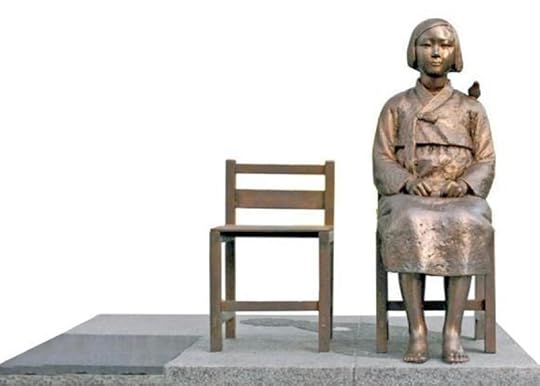 Whether in the state of California or on the prefecure of Aichi, Japan, statues of comfort women, raise the ire of certain Japanese males who would like to sweep the past under the chair.
Whether in the state of California or on the prefecure of Aichi, Japan, statues of comfort women, raise the ire of certain Japanese males who would like to sweep the past under the chair.For those not in the know, here’s a rough sketch of what happened: On August 1, the Aichi Triennale kicked off. Directed by celebrity artist Daisuke Tsuda, the Triennale aimed to close the gender gap and encourage increased participation from women artists and feminist themes. One of the main exhibits, “The Non-Freedom of Expression – What Happens Later,” caused a huge stir. Created by a Korean sculptor couple (whose identities have not been revealed in mainstream media), the centerpiece is a statue of a young Korean girl. The description says she is a comfort woman, forcibly taken from her home by the Japanese military during WWII.
On August 2, the Triennale offices are flooded with calls of protests and outrage, including one from Nagoya mayor Takashi Kawamura, who it was said, sputtered with anger all over his phone screen, and then followed that up with a written statement. Chief Cabinet Secretary Yoshihide Suga also phoned in his appearance, expressing concerns that a government funded art event was showcasing a statue loaded with anti-government sentiments – is this right? There were more than a few death threats, many of which expressed intentions to replay the recent Kyoto Animation arson incident that killed 35 people.
On August 3, Daisuke Tsuda holds a press conference announcing the cancellation of the exhibit. A controversial firestorm erupts across the archipelago.
It feels like the Japanese will never see eye-to-eye on the comfort women issue with their neighbors on the peninsula. On the list of old wounds that Japan would prefer to forget, or failing memory lapse, ignore completely – the sexual slaves known as “ianfu” or comfort women” to the western world, occupies first place. There’s something about this chunk of history that grates on Japanese male nerves, for it’s usually the men: politicians, commentators, academics and the rotund salariman sitting next to me on the subway – that get incoherent with indignation at the mere mention of the term. Last summer, I happened to be at an informal gathering when the subject came up. We were standing around a small table of drinks, and as soon as the word “ianfu” was uttered, the women scattered like sparrows and the men launched into a tirade that amounted to: “Of course there were comfort women in wartime. What else were they expecting? We were at war!”
Infuriatingly, the Japanese term for “comfort women” (慰安婦・ianfu) is comprised of the kanji characters ‘ian’ which means to console and heal, and ‘fu’ which means female. ‘Ian” is still in circulation, most often in terms like ‘ianryokou,’ which refers to annual trips that many corporations dole out to their employees, ostensibly to let them relax and have a good time. Back in the mid-Heisei era, it was still quite common for these consolation trips to include geisha attendance and jaunts to strip bars, for the benefit of their male employees. In some companies, it was the norm for executives to invite prostitutes to their hotel rooms, and put it on their company tabs. For many, many Japanese men, a woman’s value is measured by how well she consoles and heals their tired nerves. One of the highest praises that can be bestowed on a woman, remains: ‘iyasareru’ (癒やされる)meaning, “you heal me.” When the outside world (in this case South Korea) dares to put a dent in that beautiful, traditional, man-woman relationship (i.e., the brave male being healed by a willing sexual slave, regardless of nationality) which Japanese men apparently see as their birthright, it probably feels like a punch in the face. Nagoya mayor Kawamura said as much when he wrote in his statement: “The collective Japanese heart has been trampled to bits.”
Awww, what a shame.
But the incident at the Aichi Triennale shows that though their hearts are trampled, Japanese men are capable of pushing back, albeit over their smartphones. At the press conference, Triennale director Daisuke Tsuda stressed that the cancellation wasn’t due to Mayor Kawamura, or the Chief Cabinet Secretary, or anything political. “It was because of the phone calls,” he said. “The office lines were jammed with protest calls and there simply weren’t enough staff to deal with them. Everyone was working overtime anyway, and I could not, in good conscience, ask these people to deal with angry callers on top of their already considerable workloads.”
Tsuda went on to say that the decision was “heartrending” because “this will create a precedent of being able to crush work of art with anonymous phone calls.”
And now that the statue has been taken away, we have yet to assess the repercussions. As the dust settles, the ruling Liberal Democratic Party members are getting their act together to say – altogether now, boys! – that threats and violence are BAD. Freedom of expression is GOOD.
Now that we’re clear on that matter, who’s ready to address the problem of comfort women?
July 19, 2019
[The Journalist] Shines Light on Japan’s Dark Side (film review)
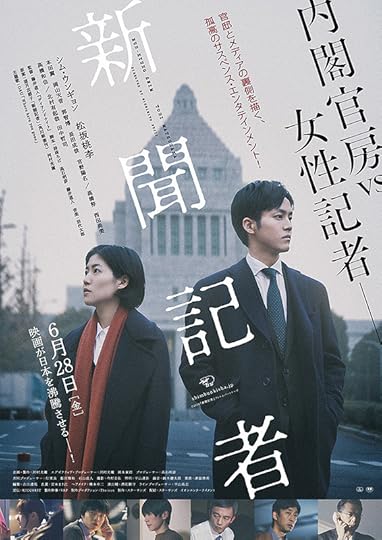
by Kaori Shoji
Shinbun Kisha (The Journalist) is getting great box office and rave reviews, belying the myth that a Japanese movie about newsrooms and politics just won’t cut it. Based on the bestselling autobiography by audacious Tokyo Shinbun (東京新聞) reporter Isoko Mochizuki, The Journalist is a suspense thriller about how the titular woman journalist dared go after the government to unveil conspiracies and cover-ups. Infuriatingly, most of her male colleagues are intent on adhering to the status quo. Alone and isolated, the journalist teams up with a young bureaucrat from ‘Naicho’ – the Cabinet Intelligence and Research Office – to expose a government scandal that’s almost an exact reenactment of Prime Minister Abe’s ‘Morikake’ incident.
“All Japan needs is a mere facade of democracy,” goes a line in this movie, implying that the nation neither needs or wants the real deal.
But now, with the House of Councillors election happening on Sunday, politics is on many peoples’ minds, including millennials that had shown zero interest in the past. Tickets in 42 theaters have sold out and the movie’s distributors announced that they will be printing 10,000 new copies of The Journalist pamphlet, as they’ve been selling off the shelves in theaters across Japan. Next week, the two main cast members will appear on stage at a theater in Shinjuku, to take their bows and answer questions from the audience. It looks like politics and newsrooms are a winning combination!
The Journalist is gripping, wrenching and ultimately cathartic, even if the plucky heroine doesn’t oust the evil government agents or get an enormous raise for her efforts. No, what happens is that news hound Erica Yoshioka (played by South Korean actress Shim Eun-kyung), after a series of grueling assignments that require round-the-clock investigating, not to mention the actual writing –gets to keep her job so she can start the cycle all over again in the name of quality journalism. Yoshioka also keeps her dignity and integrity intact, which is much more than one can say for Japanese movies about professional women, or let’s face it, women protagonists in general.
The role of Erica Yoshioka is gutsy and intriguing and you can’t help but wonder why a Japanese actress didn’t snap it up. Rumors are going around that all the possible candidates had turned it down because they didn’t want to get involved in anything anti-government and were afraid of the backlash. Shim can return to South Korea, but Japanese actresses have to live and work here.
Personally, I’ll take what I can get, and bask in the fact that The Journalist got made at all. Usually, such projects never get off the ground. Not only does The Journalist dig at some old scars the current Administration would rather forget, it bears the hallmarks of a well-meaning dud. There is no love story. There are no sex scenes or girl idols to alleviate the complete seriousness of the proceedings. And the director, Michihito Fujii, is only 32 years old with no blockbusters on his resume. Initially, Fujii turned down the offer of director since, as he professed in an online interview, “I didn’t know anything about politics or the news.”
Still, once he signed on, Fujii did the research, hit the books and lined up interviews with government officials. The story benefits from his efforts but the directing seems just a tad stiff and two-dimensional. Perhaps Fujii was too caught up in the material to do more than connect the dots, albeit with meticulous expertise.
As it is, The Journalists belong to Shim and Tohri Matsuzaka who plays Sugihara, the elite bureaucrat working for ‘Naicho’. They give their all to film and Matsuzaka has been commended on social media for taking on a “dangerous” role that could potentially give him a bad name (the anti-government name).
Compared to Shim’s Yoshioka, Sugihara is more nuanced and inwardly tortured. His job is to protect the current administration and make sure the press don’t get their hands on any problematic information, but he has his misgivings. When his boss commits suicide to cover up another cover-up, Sugihara is shaken.
(Editor’s note–this is based on the suicide of a Finance Ministry official who killed himself rather than take part in deleting or altering government documents that implicated Prime Minister Shinzo Abe in a scandal relating to a government land-sale to a right-wing elementary school, run by his crony. None of the other officials who participated in forging public documents, which is a criminal offense, were charged; the female prosecutor who dropped the case was promoted)
The boss’s last words to Sugihara had been “don’t end up like me,” and Sugihara can’t fathom whether that meant “don’t die” or “don’t get involved in anything bad.” For a Naicho bureaucrat, the two most likely mean the same thing.
Matsuzaka is a revelation – he has always been good but The Journalist shows his range. Last year, he was doing sex scenes ad nauseum in Call Boy and here, he never even takes off his jacket.
A word about Shim as Yoshioka: in the movie, her character has a Japanese father and a Korean mother, hence her accent when she speaks Japanese. Yoshioka completely lives for her job, to the point of excluding everything else from her life. It turns out that her father (also a journalist) had killed himself over an incident involving fake news. As his daughter, she had vowed to pursue the truth, whatever the cost. Shim’s performance is excellent, and one can only hope there will be a future where Japanese actresses will go for roles like this – far, far away from the planet of ‘Kawaii’.
In real life, there aren’t a whole lot of women journalists working for Japanese newspapers. Many don’t make it past the first five years; what with the long hours combined with frequent transfers to regional branches, incidents of sexual harassment, gender discrimination and of course, that thick glass ceiling – the job doesn’t exactly encourage them to stay on.
Isoko Mochizuki, the author of the book on which the film is based, however, is changing the scenery. As mentioned above, she’s a veteran reporter for Tokyo Shinbun which is famed for its hard-hitting investigative journalism and for being the Abe Administration’s most vocal critic. Her frequent cross questioning of Chief Cabinet Secretary Yoshihide Suga, has ripped a big hole in Japan’s infamous ‘kisha club’ system (where only the reporters of major newspapers are allowed to attend closed press conferences). And now, with the unexpected success of The Journalist, perhaps we can start discussing hard-hitting issues like democracy and freedom of the press. Who’s to say the Japanese don’t need it ? They seem to love films that bring up these issues.



